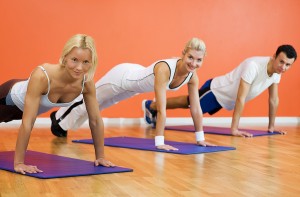 Pilates is suitable for all ages and fitness levels. Some medical problems may restrict participation in the class environment
Pilates is suitable for all ages and fitness levels. Some medical problems may restrict participation in the class environment
Pilates is based around 34 original exercises developed by Joseph Pilates over a hundred years ago. The exercises were designed to improve strength, stability, endurance, flexibility and postural awareness, whilst working the central core.
Pilates:-
- concentrates on developing the deep postural muscles of the abdominal region and spine to create a stable base.
- improves body awareness, developing better postural alignment by helping to restore mobility and flexibility.
- improves muscle activation, strength and tone with correct movement patterns.
- improves breathing control and helps to create a more balanced body.
The benefits of Pilates for the prevention and rehabilitation of injuries and back pain are now recognised by the medical world
Pilates involves eight fundamental principles:
1. Concentration
“Always keep your mind wholly concentrated on the purpose of the exercises as you perform them”. Joseph Pilates (1880-1967)
Pilates is a work-out for the mind and body. Unlike many other forms of exercise, the mind cannot switch-off. Concentration on every movement is vital to promote correct alignment and body awareness. Focused attention during each move helps improve technique, increasing precision and flow and helping prevent injury
2. Breathing
“Breathing is the first act of life. Our very life depends on it. Millions have never learned to master the art of correct breathing”. Joseph Pilates (1880-1967)
Focusing on the breathing cycle is essential in Pilates. It is one of the most difficult principles for beginners. Breathing is coordinated with exercises so exhalation occurs with movements that require the greatest effort. This provides the Spine with the greatest local muscle stability.
3. Centering
“Pilates develops the body uniformly, corrects wrong postures, restores physical vitality invigorates the mind and elevates the spirit”. Joseph Pilates (1880-1967)
In Pilates your centre is your “powerhouse”. Pilates exercises primarily facilitate core stability and then challenge this through various arm and leg movements, thus developing an efficient “powerhouse”. This is vital to protect your back against the stresses and strains of day to day life (i.e. lifting and bending). Anyone who suffers from lower back pain will have weaker spinal muscles, and unless they are specifically strengthened we will be more susceptible to back injuries in the future.
4. Control
“Good posture can be successfully acquired only when the entire mechanism of the body is under perfect control”. Joseph Pilates (1880-1967)
Muscle control is essential in order to maintain correct posture and alignment when working the muscles. The exercises in Pilates strengthen the muscles by working against gravity using slow and controlled movements.
5. Precision
“The benefits of Pilates depend solely on your performing the exercises exactly according to the instructions”. Joseph Pilates (1880-1967)
Precision of movement is a long term goal in the Pilates method. Routine in the techniques creates precision which leads to greater awareness and control.
6. Flowing Movement
“Designed to give you suppleness, grace and skill that will be unmistakably reflected in the way you walk, the way you play and in the way you work”. Joseph Pilates (1880-1967)
Pilates exercises are generally slow, precise and always flowing in movement. It is so much harder to do an exercise slowly and with control than to rush through it and use the wrong muscles. Pilates exercises are performed in time with the breathing – nothing is forced or strained. Movements should be continuous, lengthening away from a strong core
7. Integrated isolation
“Each muscle may cooperatively and loyally aid in the uniform development of all our muscles”. Joseph Pilates (1880-1967)
Pilates builds mind-body awareness, thus kinaesthetic awareness. Routine in Pilates allows one to recognise incorrect patterns or movement, isolate them and correct them. It is necessary to develop an awareness of the different parts of the body to effectively perform the various exercises, so that the individual exercises can be practiced in a precise and controlled way.
8. Routine
“Make up your mind that you will perform your Pilates movements 10 minutes (each day) without fail”. Joseph Pilates (1880-1967)
As with any exercise therapy, repetition leads to greater skill and greater benefits.


